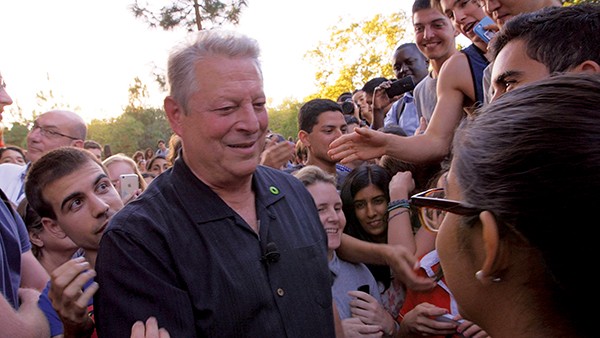About a third of the way into An Inconvenient Sequel: Truth to Power, something remarkable happens: Al Gore gets mad. The moment comes during a training session for climate activists, where Gore is passing on the knowledge in his persuasive and ever-evolving Keynote presentation describing the problem of global warming and proposing solutions. For a moment, the famously low-key vice president gets caught up while describing the efforts of the fossil fuel industry to sew doubt about the reality of what he calls the climate crisis. His voice coarsens into a shout, his eyes narrow, and he pumps his fist into the air. Then, he catches himself, stops, and takes a deep breath. The crowd of 300 or so progressives burst into applause and shouts. But Gore doesn’t take the bait and start ranting. Instead, he apologizes, quiets the crowd, and gets back down to business.
It’s a small moment that reveals much about Gore’s character. He kept his cool as the presidency was stolen from him, but he finally loses it when he allows himself to think about the sheer magnitude of the petty, greedy, self-serving, willfully ignorant jackholes who would risk the complete collapse of human civilization just to keep their companies’ stock prices up. If I were Al Gore, I would be frothing with rage all the time. And maybe, down deep, he is. But he’s too disciplined and too focused to let it slip out, and that’s why he’s the one with the Nobel Peace Prize.
When it premiered at Sundance in 2006, An Inconvenient Truth was the right movie at the right time. Climate change denier George W. Bush had won re-election, but his inept handling of Hurricane Katrina in late 2005 had caused the blinders to fall away for a large part of the electorate. The core of the film was just the same slideshow Gore had been polishing since he walked away from a two-decade-long political career in the wake of the 2000 election debacle. But the information was so well presented and so alarming, and Gore’s presence so comfortingly professorial, that the movie became the 10th highest grossing documentary of all time and earned two Academy Awards.

Al Gore (above) keeps his cool — even while he warns of a global meltdown.
For a time, An Inconvenient Truth seemed to turn the tide against climate denial. Much progress has been made over the ensuing decade. Gore spends a considerable amount of time in An Inconvenient Sequel talking about the advances in wind and solar power generation. The climax of the film follows Gore as he is part of the team of negotiators trying to close the deal in the 2016 Paris Climate Accords, where he helps negotiate a solar technology transfer to India.
But for a 2017 viewer, what was supposed to be the triumphal moment of the film — the signing of the Paris Climate Agreement by 196 countries — comes across as a harbinger of doom. We know the delicate progress was undercut by the election of Donald Trump, a dedicated climate change denier who promises to withdraw the United States from the agreement. In the words of The Big Lebowski, the plane has crashed into the mountain.
The consequences of continuing to burn fossil fuels are not left to the viewer’s imagination. The film’s most incredible footage — some of the most incredible footage in any film ever — comes from a helicopter pilot flying over Greenland during the hottest day ever recorded on the Arctic island. We see a glacier not so much collapsing as exploding. Thousand-foot spires of ancient ice collapse into clouds of steam. It’s like the buildings exploding in a city-destroying climax of an Avengers movie, only it’s real. Later, Gore is taken on a tour of Miami Beach by the city’s mayor. High tides now routinely flood the city. A city engineer tells Gore of a plan to raise an eroding roadbed by a foot. Gore tells him the sea is expected to rise by at least seven feet. It’s moments like that when you think maybe it would be a good idea if Gore got mad in public more often.